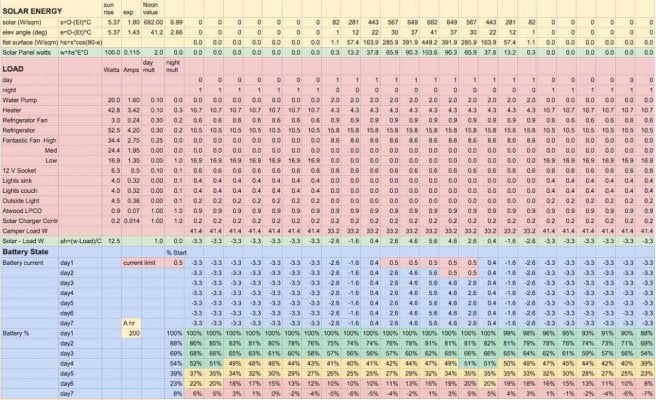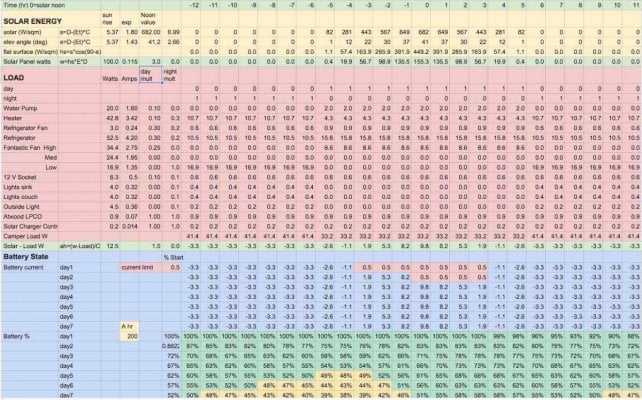carld
Senior Member
I may have overstated it a bit about the battery limiting the current, although it does decline and the battery approaches 100%, and it will help to add more solar power. This is way overkill but it is an interesting subject to me so here goes. Here in Plano TX the cities website shows the solar power W/sqm for each day. About now it's peaking around 680 W/sqm at solar noon, 12:40 pm. For today sun rise and sun set are 5.37 hrs before and after solar noon. Using a power curve y=680 x abs(Kt)^p curve, I found K and p to approximate the solar power for a sunny day here. I then did the same to approximate the solar elevation angle for today, here in Plano it reaches 41.2 deg at solar noon. I projected this solar energy onto a horizontal (flat roof mount) solar panel and multiplied that by the effective solar panel area for 2 100 W panels to get solar panel watts.
The camper load is different at different times of the day so the second section finds the camper load each hour for one day. The difference (solar panel watts- camper load) is the available battery current. Starting with a 100% battery charge at sunset, limited the battery current to 0.5 amps if the battery is more than 80% charged and found the % charge for the battery. Day after day the ending % charge is copied to the new day % start. The first screen shot is for 200 W panels (Solar panel watts multiplier =2) and 200 Amp hr Battery. The second shot is for 300 W panels and 200 Amp hr.
In Portland Oregon the solar elevation angle is 12 deg less, the solar intensity is about half, 341 w/sqm, and the solar day is slightly longer 5.82 hr.
It appears that I overestimated the Load. I have it at 72 amp hr so things should look a lot better at 50 amp hr.
The camper load is different at different times of the day so the second section finds the camper load each hour for one day. The difference (solar panel watts- camper load) is the available battery current. Starting with a 100% battery charge at sunset, limited the battery current to 0.5 amps if the battery is more than 80% charged and found the % charge for the battery. Day after day the ending % charge is copied to the new day % start. The first screen shot is for 200 W panels (Solar panel watts multiplier =2) and 200 Amp hr Battery. The second shot is for 300 W panels and 200 Amp hr.
In Portland Oregon the solar elevation angle is 12 deg less, the solar intensity is about half, 341 w/sqm, and the solar day is slightly longer 5.82 hr.
It appears that I overestimated the Load. I have it at 72 amp hr so things should look a lot better at 50 amp hr.


